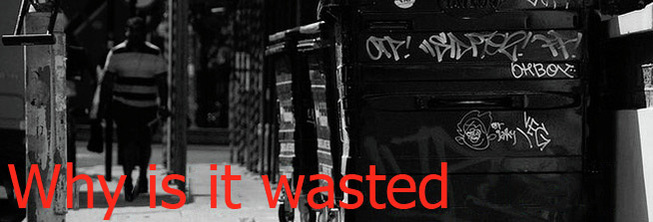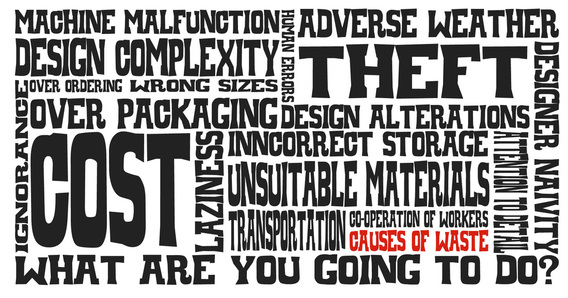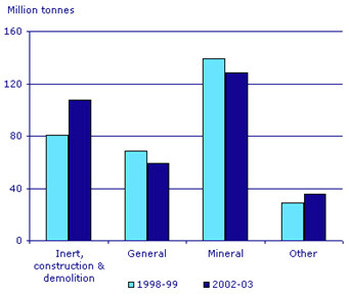- Home
- Project Waste
- Statistics
- What's Wasted
- Why is it Wasted
- Material Lifecycle
- Recycling
- Landfill
- Smart Manufacture
- Design for Disassembly
- Simple Construction
- Avoiding Wasteful Techniques
- Legislation & Policy
- Case Studies
Modern society must drastically change it's ways in order to stop waste issues escalating.
Overview
This page explores the reasons why we as humans create so much waste. It will provide a general overview of 'why we waste' in general, tackling three of the main issues. Then focusing specifically on waste in construction, where four key areas have been identified as the main causes for waste.
Ethical, Social and Industrial Causes of Waste

"Modern society is frequently taking for granted the things that we use every day."
"Products that are produced nowadays are unnecessarily over-packaged."
What are the reasons behind human waste? Why do we waste so much in modern society? These are the questions that people are beginning to ask in a world where waste is rapidly increasing and becoming a huge problem.
So what are the issues surrounding the ever increasing problems of waste? The answers lie within the life cycle of materials and the interactions that the materials experience. We can begin by looking at the manufacturing of products in industry and mass production in factories. Modern society is frequently taking for granted the things that we use every day. We are coming to expect so much from the products that we buy and are so obsessed with getting value for our money that we don't take time to think about the impact that we might be having on the environment. Products that are produced nowadays are unnecessarily over-packaged and there are so many novelty packaging methods that you end up with a hell of a lot of waste just from one small product. This fact alone is contributing to a vast amount of the waste that we produce every day and we should be asking ourselves: is it really necessary?
"We have forgotten the ways of using and re-using products."
"It is cheaper to discard an item and replace it with a new one."
Moving forward, the next phase is looking at the nature of the human being and how they interact and use everyday items. Our culture in the UK is a very narrow minded way of using products that we buy. We have forgotten the ways of using and re-using products. As soon as something is no longer fit for its purpose we merely discard the item and purchase a replacement, before even thinking about how it may be used elsewhere and whether it could be fixed or be useful to somebody else. This is down to a financial reason, it is cheaper to simply discard and replace the item rather than spending time getting it fixed or re-using it for another purpose. We would much rather waste our landscape than waste our time and money? Which is more important and which is more detrimental to us as a race in the long term?
"The mining and quarrying industries produce 122.1 million tones of waste per year."
This brief overview of waste are the main reasons why people waste in everyday life. These ideas and concepts can also be applied to the construction industry. The main sources of waste are the construction industry, the mining and quarrying industries and UK households, which generated 122.1 million tonnes, 95.9 million tonnes and 30.9 million tonnes respectively per year. Waste from those three sources accounted for 75 per cent of all UK waste generated in 2002/03. That number in respect to the construction industry has risen by 25% since 1998/99.
This brief overview of waste are the main reasons why people waste in everyday life. These ideas and concepts can also be applied to the construction industry. The main sources of waste are the construction industry, the mining and quarrying industries and UK households, which generated 122.1 million tonnes, 95.9 million tonnes and 30.9 million tonnes respectively per year. Waste from those three sources accounted for 75 per cent of all UK waste generated in 2002/03. That number in respect to the construction industry has risen by 25% since 1998/99.
Why we waste in the Construction Industry
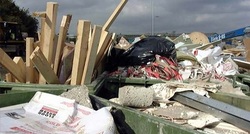
Waste produced in the construction industry is astronomical and is still rising. Initiatives are to be put in place but drastic measures need to be taken and it seriously needs to improve. The reasons for waste can be split into four main categories: Design, Procurement, Handling of materials and Operation. Considering factors that come under these four headings we can identify why we waste in the construction industry.
Design

"Lack of attention paid to the dimensions of a specific material."
"Ongoing changes that are made to the initial design."
The design of a building or construction project is a very precise art and need a lot of due care and attention. Waste can often occur when lack of attention is paid to the dimensions of a given material in relation to the dimensions of the building, this leads to beams and joists etc being too long and the resulting off cuts from this are wasted. Another reason can be ongoing changes that are made to the design which results in piece being taken down or altered to suit the new design. This ultimately causes waste through the design no longer requiring a certain component.
"Inexperience of the designer and poor knowledge of conventional sizes."
"Detail designs too complex for the contractor to understand."
These reasons can sometimes come from the inexperience of the designer and their unfamiliarity with conventional sizes that the trades use. This will account for a lot of wastages, as,if the mistake is made for one order everything on that order is then wrong and is useless. A lot hinges on the designers competence in the initial stages of construction in order to avoid wasting materials. This means that they have a responsibility to show sufficient detail in their drawings so that the material and the dimensions of that material are correct. However, this is sometimes not the case and leads to the contractors guessing and from time to time getting it wrong. This can also work in the opposite way, if the designer puts too much detail into a complex element of the building the contractor can become confused and this also leads to mistakes and wastages occurring.
"Ongoing changes that are made to the initial design."
The design of a building or construction project is a very precise art and need a lot of due care and attention. Waste can often occur when lack of attention is paid to the dimensions of a given material in relation to the dimensions of the building, this leads to beams and joists etc being too long and the resulting off cuts from this are wasted. Another reason can be ongoing changes that are made to the design which results in piece being taken down or altered to suit the new design. This ultimately causes waste through the design no longer requiring a certain component.
"Inexperience of the designer and poor knowledge of conventional sizes."
"Detail designs too complex for the contractor to understand."
These reasons can sometimes come from the inexperience of the designer and their unfamiliarity with conventional sizes that the trades use. This will account for a lot of wastages, as,if the mistake is made for one order everything on that order is then wrong and is useless. A lot hinges on the designers competence in the initial stages of construction in order to avoid wasting materials. This means that they have a responsibility to show sufficient detail in their drawings so that the material and the dimensions of that material are correct. However, this is sometimes not the case and leads to the contractors guessing and from time to time getting it wrong. This can also work in the opposite way, if the designer puts too much detail into a complex element of the building the contractor can become confused and this also leads to mistakes and wastages occurring.
Operation

"Errors made by trades person or labourer during construction."
"Mistakes can occur throughout the whole design process."
Operational procedures during a construction project are key to minimising waste. Waste cannot always be avoided however due to the nature of humans to make errors and be careless. Waste often occurs due to errors made by tradespersons and labourers during the construction. This can be anything from attaching the wrong pieces together to fitting a component the wrong way. The reasons why it is such a huge contributor to waste is because these errors can occur at every stage of the construction from laying the foundations to fitting the final fixtures.
"Equipment failure/malfunction can lead to damages and therefore wastages."
"Incorrect storage of materials can lead to rotting, warping and rusting."
Some operational factors however are not always down to human error. For example an equipment malfunction or failure can often cause damage to a material or component and result in a waste of that material. Mechanical failure cannot be predicted and is just one of the unfortunate parts of construction because the machines we use are key in helping us construct the building. Also, incorrect storage of materials can lead to rotting, warping and rusting of materials. These two factors can be minimised by looking after and maintaining equipment and storing materials correctly overnight.
"Mistakes can occur throughout the whole design process."
Operational procedures during a construction project are key to minimising waste. Waste cannot always be avoided however due to the nature of humans to make errors and be careless. Waste often occurs due to errors made by tradespersons and labourers during the construction. This can be anything from attaching the wrong pieces together to fitting a component the wrong way. The reasons why it is such a huge contributor to waste is because these errors can occur at every stage of the construction from laying the foundations to fitting the final fixtures.
"Equipment failure/malfunction can lead to damages and therefore wastages."
"Incorrect storage of materials can lead to rotting, warping and rusting."
Some operational factors however are not always down to human error. For example an equipment malfunction or failure can often cause damage to a material or component and result in a waste of that material. Mechanical failure cannot be predicted and is just one of the unfortunate parts of construction because the machines we use are key in helping us construct the building. Also, incorrect storage of materials can lead to rotting, warping and rusting of materials. These two factors can be minimised by looking after and maintaining equipment and storing materials correctly overnight.
Procurement
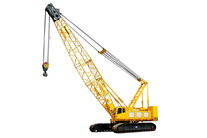
"Errors in the ordering of the materials: too much or the wrong size."
"Materials arriving in the wrong size or amount than the order specified."
Procurement deals with the ordering issues which can cause wastages during construction. The main reason that falls under this category is errors in the ordering of materials. For example, order significantly more than you need and therefore you have excess material left over and it then has to be wasted. Also there is the scenario in which you order specific materials and they arrive incorrectly, whether they are the wrong size or whether they are the wrong thing altogether. This in turn can lead to wastages being made.
"Products that do not comply with the building specifications."
Wasting also occurs when products are purchased that do not comply with the specifications. Whether it be the specifications of building regulations or the specifications of the grand scheme of the design. Either way the materials therefore become useless and have to be wasted.
"Materials arriving in the wrong size or amount than the order specified."
Procurement deals with the ordering issues which can cause wastages during construction. The main reason that falls under this category is errors in the ordering of materials. For example, order significantly more than you need and therefore you have excess material left over and it then has to be wasted. Also there is the scenario in which you order specific materials and they arrive incorrectly, whether they are the wrong size or whether they are the wrong thing altogether. This in turn can lead to wastages being made.
"Products that do not comply with the building specifications."
Wasting also occurs when products are purchased that do not comply with the specifications. Whether it be the specifications of building regulations or the specifications of the grand scheme of the design. Either way the materials therefore become useless and have to be wasted.
Handling
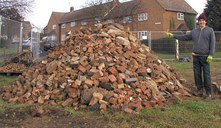
"Human handling of materials leading to breakages."
"During transportations of materials from trade yard to the building site."
Damages can occur during the construction which renders that material useless and therefore has to be thrown away. If something is broken it is no longer suitable for its intended purpose or for any other purpose in the construction. Breakages can be minor and not affect the waste at all but others may be on a larger scale and produces a lot of waste. This can be related to the point made earlier about using and re-using. If something breaks during the construction it is immediately thrown away and replaced without first considering whether it might be recycled and used elsewhere. The way people behave in everyday life can also be applied to the construction of a building. Damages can also occur during the transportation of the materials from the traders site to the building site itself.
"Adverse Weather conditions can lead to disfigurement of materials."
Furthermore, adverse weather conditions can result in the ruin of materials so that they are not longer suitable, for example the warping of timber so that it is not longer the required shape and no longer fits where it is supposed to go.
"Temperament and co-operation of labourers."
There are matters to deal with other than the handling of the materials and that is the handling of your workforce and labourers. If they develop an unfriendly attitude then they will be less careful with the materials and may even damage something on purpose.
"Theft of materials from the building site."
Finally, another matter which can cause wastages is theft. If some of your material is stolen then that has to be replaced which is wasting money on extra materials that could have been used in other areas of the construction project.
"During transportations of materials from trade yard to the building site."
Damages can occur during the construction which renders that material useless and therefore has to be thrown away. If something is broken it is no longer suitable for its intended purpose or for any other purpose in the construction. Breakages can be minor and not affect the waste at all but others may be on a larger scale and produces a lot of waste. This can be related to the point made earlier about using and re-using. If something breaks during the construction it is immediately thrown away and replaced without first considering whether it might be recycled and used elsewhere. The way people behave in everyday life can also be applied to the construction of a building. Damages can also occur during the transportation of the materials from the traders site to the building site itself.
"Adverse Weather conditions can lead to disfigurement of materials."
Furthermore, adverse weather conditions can result in the ruin of materials so that they are not longer suitable, for example the warping of timber so that it is not longer the required shape and no longer fits where it is supposed to go.
"Temperament and co-operation of labourers."
There are matters to deal with other than the handling of the materials and that is the handling of your workforce and labourers. If they develop an unfriendly attitude then they will be less careful with the materials and may even damage something on purpose.
"Theft of materials from the building site."
Finally, another matter which can cause wastages is theft. If some of your material is stolen then that has to be replaced which is wasting money on extra materials that could have been used in other areas of the construction project.
The Verdict
In my opinion, the main causes of wastages on the building site are mostly down to human judgement, skill and error. There are measures and precautions that can be put in place to try and reduce these wastages However, there are some factors that cannot be controlled.
By Michael Burns
